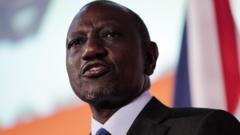Is William Ruto Kenya’s Most Disliked President Ever?

Understanding the Current State of Kenya Under President William Ruto
In recent months, Kenya has witnessed a significant shift in public sentiment towards its leadership, particularly towards President William Ruto. Once regarded as a beacon of hope and change, Ruto now finds himself grappling with escalating public discontent. This article delves into the complexities of Ruto's presidency, exploring the factors that have contributed to the current state of unrest and dissatisfaction among the Kenyan populace.
The Promises of Change
William Ruto's rise to the presidency was marked by a wave of enthusiasm from ordinary Kenyans who believed in his vision for a better future. His narrative was one of resilience and relatability; having emerged from humble beginnings as a chicken seller, he positioned himself as a champion of the common man. Ruto's campaign resonated with many, especially those disillusioned by the political elite's failure to address their needs.
However, as Ruto assumed office, expectations soared. Kenyans anticipated immediate improvements in their quality of life, driven by promises of economic growth, job creation, and social welfare programs. Yet, as the months rolled on, the reality of Ruto's governance began to starkly contrast with the hopeful rhetoric of his campaign.
The Unfolding Crisis
As of now, the public's faith in Ruto's leadership has waned significantly. Protests have erupted, demanding accountability and change, with slogans like "Ruto must go" becoming rallying cries for the disenchanted. Analysts describe the current wave of criticism as "unprecedented," highlighting a unique convergence of anger that transcends ethnic, religious, and socioeconomic lines.
Public Outrage and Its Implications
The intensity of the backlash against Ruto has been striking. Over the past year, protests have resulted in the deaths of at least ten individuals, a tragic statistic that underscores the severity of the situation. Kenyans, united in their grievances, have been vocal about issues such as rising living costs, rampant corruption, and police brutality.
Ruto himself has expressed frustration, questioning why public outrage seems disproportionately directed at him compared to his predecessors, such as Daniel arap Moi and Mwai Kibaki, who ruled during tumultuous times characterized by political repression and human rights abuses. His comments, however, have sparked further outrage, highlighting the disconnect between his administration and the people.
The Role of Social Media in Shaping Public Discourse
The role of social media in amplifying public sentiment cannot be underestimated. With a digitally savvy youth population, information spreads rapidly, and dissent finds a platform. The phrase "We are all Kikuyus" trended on social media as young Kenyans rejected the ethnic divisions that have historically plagued the political landscape. This shift signals a desire for unity amid growing unrest.
Academics and political analysts suggest that this time, the criticism of Ruto is not merely ethnic or class-driven. Instead, it reflects a broader discontent that spans diverse communities across urban and rural settings. This unprecedented level of public outcry points to a fundamental crisis in governance and trust between the state and its citizens.
Government Response and Escalating Tensions
In response to the protests, the Kenyan government has resorted to forceful crackdowns, leading to mass arrests and allegations of human rights abuses. Such tactics have only deepened public outrage and alienated citizens further, as the police have been accused of excessive violence in an attempt to quell dissent. More than 100 lives have been lost in the ongoing unrest, turning grief into a potent catalyst for continued protests.
Political communication expert Hesbon Owilla describes the unrest as "probably the most intense outrage against a regime" in Kenya's history. The collective frustration is fueled by unmet expectations and a growing perception that Ruto's administration has failed to deliver on its promises. The disillusionment among Kenyans is palpable, with many feeling abandoned by their leadership.
The Economic Dimension of Discontent
Central to the public's grievances is the issue of economic hardship. The rising cost of living, coupled with aggressive taxation policies, has left many Kenyans struggling to make ends meet. The introduction of a 1.5% housing levy and a 2.75% health insurance tax has exacerbated frustrations, as citizens feel the burden of higher taxes without commensurate improvements in public services.
While Ruto's administration has launched various initiatives aimed at addressing these challenges—such as the affordable housing project and universal healthcare scheme—the impact has been slow to materialize. Critics argue that the government's efforts have not been sufficiently effective to alleviate the urgent economic pressures faced by ordinary citizens.
Promises vs. Reality
Ruto's initial promises of uplifting ordinary Kenyans have transformed into a narrative of disappointment. The disconnect between the administration's claims and the lived experiences of citizens has fostered a pervasive sense of betrayal. Many Kenyans are left waiting for the promised changes to manifest, but as time passes, hope diminishes.
The Ideological Clash
Another layer to the current discontent is the perceived ideological mismatch between Ruto's conservative political outlook and the more progressive values embraced by a significant portion of the population, particularly the youth. This divergence has intensified tensions, as young Kenyans increasingly seek leaders who resonate with their aspirations for a more inclusive and equitable society.
In this context, the president's rhetoric often exacerbates the situation. His recent comments advocating for police to shoot protesters in the legs rather than lethal force drew widespread condemnation and mockery. Such statements not only reflect a degree of desperation but also highlight a lack of understanding of the gravity of the public's frustrations.
The Future of Ruto's Presidency
As Ruto navigates this turbulent landscape, the future of his presidency hangs in the balance. The ongoing protests, driven by a mix of economic hardship and unmet expectations, pose a significant challenge to his administration. The public's patience is wearing thin, and unless meaningful changes are implemented, the potential for further unrest remains high.
Several key questions loom over Ruto's presidency: Can he rebuild trust with the Kenyan people? Will he be able to address the economic grievances that have fueled discontent? And crucially, how will he reconcile his administration's conservative stance with the progressive aspirations of the youth?
Conclusion
The landscape of Kenyan politics has shifted dramatically under President William Ruto's leadership. Once seen as a figure of hope, he now faces unprecedented levels of public outrage. The convergence of social media, economic hardship, and a desire for unity among diverse communities has created a complex environment for governance.
As the nation grapples with its future, Ruto's ability to respond to the challenges at hand will determine not only his presidency but also the broader trajectory of Kenya's political landscape. The call for accountability and change resonates loudly, and the actions taken in the coming months will be pivotal in shaping the nation's path forward.
FAQs
What led to the current unrest in Kenya under President Ruto?
The unrest stems from a combination of rising living costs, aggressive taxation, and unmet expectations regarding Ruto's promises for economic improvements and social welfare programs.
How has social media influenced public sentiment in Kenya?
Social media has played a significant role in amplifying public grievances, allowing diverse communities to unite in their discontent and facilitating broader discussions about governance and accountability.
What has been the government's response to the protests?
The Kenyan government has responded with forceful crackdowns, resulting in mass arrests and allegations of human rights abuses, which have further fueled public outrage and unrest.
As Kenya navigates this challenging period, one must ponder: What steps can be taken to bridge the widening gap between the government and its citizens? #KenyaPolitics #WilliamRuto #PublicDiscontent
Published: 2025-07-12 03:11:27 | Category: world



